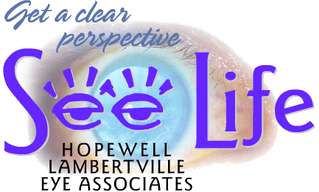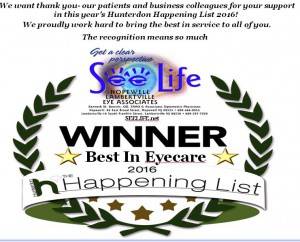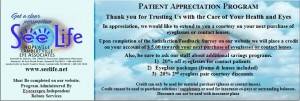Help protect patients by discussing sport and safety eyewear at every patient encounter
By Kenneth Daniels, OD, FAAO
Consider the patient who experienced an alkaline burn to the cornea, the patient who had a thorn enter her left eye; the patient whose weed whacker belt injury penetrated his cornea; the patient who was hit in the eye by a Nerf ball, resulting in a commotio retinae; and the patient whose paint ball injury left her aphakic, with a retinal detachment and aniridia. In all these cases (see subsequent images), the simple use of protective eyewear could have prevented the devastating injuries incurred by these individuals.
Here are simple steps to follow with every patient to help protect your patients’ vision while they are enjoying their everyday activities.
ASK QUESTIONS
As we delve into the history of each of our patients, it is simple enough to ask in which activities they participate and then address the need based on that activity, be it avocation or occupation.
For example, I am a cyclist and will bring my experience to the conversation stating to a patient that I use a sweep-back frame design to reduce wind shears and dust and a lens switching system to select the appropriate lens color set based on the environmental lighting. But, we do not need to be athletes or weekend warriors to understand a patient’s activities. The simple art of conversation will elicit the requirements of their lifestyle. The engagement with the patient by the doctor and the O.D.’s recommendations for safety eyewear allow for the transfer of information, leading to the ease of conversation and education reinforcement by your optical staff.
In our practice, we see a large number of lab workers, scientists from universities and pharmaceutical firms. We always ask about the safety requirements of their labs and refresh them on OSHA regulations.1-3 For example:
“Your job sounds very interesting. Do you require eyewear to meet safety OSHA regulations? If so, we can discuss the use of contact lenses and safety eyewear, or the various options for safety eyewear that we can fabricate for you.”
We also see many athletes from area high school and college teams, each requiring unique options for their sport. We always discuss the needs of the sport and their equipment — helmets, goggles, face shields — as well as what corrective eyewear the athletes presently use and how we can design appropriate systems for them.
For example, a few years ago we had a competitive collegiate swimmer who had keratoconus. She was fit with a piggyback contact lens system in which we had her wear the GP lens under the soft lens to avoid lens loss in conjunction with her swim goggles.
Another case: We had a competitive senior circuit marksman who shoots skeet bring in several skeets (target disks), and we matched lens color to contrast the skeet and fit these lenses into a safety frame.
PERFORM THE EXAM
The patient’s annual comprehensive eye exam will allow optometrists to identify any refractive error and medical eye issues that need addressing to meet the visual demands of the patient’s avocation or occupation.
In our practice, we make an effort to address each individuals’ needs by discussing the option of contact lenses as an alternative vision correction in conjunction with safety/sport eyewear. I also refer to colorimetry charts to design the proper tinting or lens coloration to enhance the sport, such as for golf, tennis, shooting, water sports and others. In discussing refractive wear options, we will also recommend various photochromic lens options, UV and blue light blocking lenses, AR-filtering and sport-specific color-enhancing lenses (i.e., light-stabilizing lenses for golf, light blue-based lenses for tennis, yellow for shooting, polarization for water sports, etc.). Additionally, I keep sports equipment in the office, such as a golf club, toy rifle, tennis racquet, shooting skeets, and even ask the patient to bring in their own equipment (i.e., crossbow, rifle or handgun, without ammunition) to assist in the contact lens selection and/or adjunct sport/eyewear. This allows us to select the appropriate frame and lens or contact lens design.
An example, and one of the more visually difficult sports, especially for presbyopia patients, is archery. This is due to the archer’s need to position the string in close proximity to the eye (approximately <10 inches vertex), visualize the front of the bow (approximately 24 inches), the arrow tip (30 inches) and the distant target (various). In this case, we fit the shooter with a centered-distance multifocal lens that has a +1.50 D add, allowing the archer to optimize distance, intermediate and near visualization.
EDUCATE ON SAFETY STANDARDS
Reinforce to patients that sport/safety eyewear, although readily available elsewhere, is not prescriptive and does not come with the advice of the eye care practitioner. Continue by explaining that optometrists can provide the following safety measures:
Sports/safety eyewear standards: Educate patients on the American Society for Testing Materials (ASTM) International and American National Standards Institute (ANSI) standards that qualify sport/safety eyewear differently as compared to traditional dress eyewear. Specifically, two important U.S. standards for protective eyewear are ASTM F803 and ANSI Z87.1
Protective sports eyewear are eyeglass frames or goggles designed and manufactured to meet or exceed applicable U.S. impact protection standards. All protective sports eyewear must have polycarbonate lenses designed to withstand impact. Benefits to polycarbonate lenses include UV protection and scratch resistance. The material has also been used to create high impact-resistant frames.
Local regulations: In New Jersey, since 2006, the state mandates the use of protective eyewear in organized sport. “Any child who wears corrective eyeglasses while participating in racquetball, squash, tennis, women’s lacrosse, basketball, women’s field hockey, badminton, paddleball, soccer, volleyball, baseball or softball, sponsored by a school, community or government agency, shall be required to wear protective eyewear that meets the frames standards of the American Society for Testing and Materials (ASTM) F803 and lens standards of the American National Standards Institute (ANSI) Z87.1.” O.D.s should identify whether such laws exist in their area, and inform patients of it as the eyewear recommendation is made.
Appropriate fit: Finally, let the patient know that sport/safety eyewear also must be properly fit to the individual to provide adequate protection. It is particularly important with children to find the correct sizing and design (i.e., for helmet-based sport) and allow a slight “room to grow” scenario.
Additionally, sport/safety eyewear may obstruct peripheral vision, leading to poor performance with a potential for impact from unseen sources to one side or another. The design of the recommended eyewear should address and facilitate the activity without visual hindrance. In the case of incorporated padding, make sure the padding on the frame bridge and inside the sides of the goggle rests flush with the face, and the eyes are centered in the lens area. The fit should also allow for proper air venting to prevent fogging.
Finally, optometrists should review the fit of patients’ sports eyewear each year to ensure proper protection and fit.
MAKE THE RECOMMENDATION
To complement the prescription for vision correction, my practice offers numerous eyewear options and discusses their pros and cons. We refer back to our findings based on the information gathered during the exam and the education on safety standards when providing a recommendation. For example, perhaps a child’s everyday activity exceeds the durability of dress eyewear. In such a case, we can offer a youth-friendly dress wear safety frame line fabricated with a polycarbonate lens.
ADDRESS PATIENT NEEDS
Practitioners do not need to know every sport or occupation, but through the simple conversation of occupational and avocational needs, we will learn, understand and properly address the patient’s visual needs. This could be contact lenses, computer lenses, sport or occupational-specific eyewear, PPE (see sidebar) or a combination.
Writing the prescription is only step one. Step two is to work with the optical staff to reinforce your conversation and transfer the discussion of educating the patient to fulfilling their needs. In all, we are not selling a second pair of glasses, we are addressing lifestyle needs and safety to avoid temporary or life-long loss of vision. OM
Personal Protective Equipment
MANY OF THE SPORT/SAFETY OPTIONS will meet the needs of the individual for PPE in the workplace. If the eyewear is to be used as PPE, consider the environment the patient is working, which will have different requirements, needs for cleaning, disinfection and replacement. Our heroic frontline workers still have refractive requirements, but the complexity of PPE and OSHA in concert with required protective garb entails a bit more homework on the optometrist’s part. As such, we need to be educated, informative and creative, using combinations of contact lenses, protective eyewear, shields and/or head-mounted protection. Frame and lens manufacturers can help us to accomplish this.
REFERENCES
- Standard 1910.133 – Eye and face protection. Occupational Safety and Health Administration, United States Department of Labor website. Last updated March 25, 2016. Accessed Jan., 17, 2021. https://www.osha.gov/laws-regs/regulations/standardnumber/1910/1910.133
- Standard 1926.102 – Eye and face protection. Occupational Safety and Health Administration, United States Department of Labor website. Last updated March 25, 2016. Accessed Jan., 17, 2021. https://www.osha.gov/laws-regs/regulations/standardnumber/1926/1926.102
- Standard Interpretations OSHA requirement for updating Prescription Safety Glasses – Eye and face protection. Occupational Safety and Health Administration, United States Department of Labor website. Published Feb. 4, 2013. Accessed Jan., 17, 2021. https://www.osha.gov/laws-regs/standardinterpretations/2013-02-04-2#:~:text=The%20standard%20includes%20the%20requirement,be%20worn%20over%20the%20prescription
- New Jersey State Law. An act concerning protective eyewear for certain children and supplementing Title 5 of the Revised Statutes. P.L.2005, c.306. https://www.njleg.state.nj.us/2004/Bills/PL05/306_.pdf Accessed Jan. 17, 2021.




